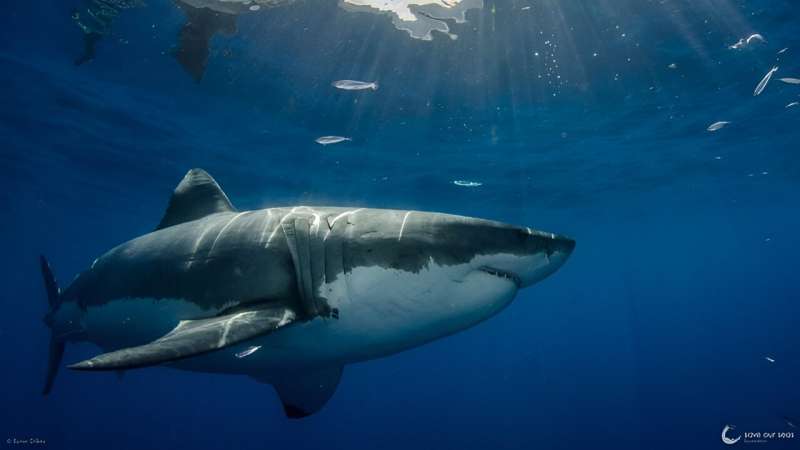This article has been reviewed according to Science X's editorial process and policies. Editors have highlighted the following attributes while ensuring the content's credibility:
fact-checked
peer-reviewed publication
trusted source
proofread
Birds of a feather flock together but great white sharks have swum apart 'forever'

Great white sharks separated into three distinct population groups up to 200,000 years ago and continue to mix only within these separate groups, new research has found.
Lead investigators in a global collaboration, scientists at the University of Aberdeen have applied cutting-edge novel genome analyses to white shark populations around the world for the first time, and they published their results in the journal Current Biology.
They found that there are three distinct geographic lineages which seldom interbreed; a southern Pacific Ocean population (Indo-Pacific), a northern Pacific Ocean population and a population in the North Atlantic and Mediterranean.
The discovery means the global populations of white sharks are at greater risk of extinction than previously thought as each rely on a smaller number of the species, with individuals from one lineage unlikely to make up shortfalls in another.
The research at Aberdeen was led by Dr. Catherine Jones in partnership with Nord University, the Oslo Sequencing Center, Potsdam University, and with collaborators around the world, including the Guy Harvey Research Institute at NSU, Florida, the MedSharks project, Italy, and Oceans Research Institute, South Africa, enabling the collection of biopsies throughout much of the white shark's range.
Dr. Jones said, "At the end of the Penultimate Ice Age—between 100,000 to 200,000 years ago—white shark populations appear to have divided into three discrete lineages which seldom interbreed.
"This separation can still be observed today as modern major ocean currents seem to act as boundaries of the areas occupied by each group.
"If all the white sharks belonged to a single large, integrated global population, it would not matter so much if they vanished from a specific area. But if white sharks comprise separate genetically distinct populations, such as in the Mediterranean, and this were lost, unique genetic diversity would also be lost."

Researchers say understanding the distribution and health of these distinct groups is key to future protection of the species.
Professor of Aquatic Biosciences at Nord University in Norway, Les Noble, who also holds an honorary position at the University of Aberdeen added, "Successful conservation requires recognition of management units, but this has been unavailable for white sharks, which were suspected to exist as a single global population."
"Although not widely appreciated, man's future is increasingly bound up with that of white sharks. As top predators they play a crucial role in maintaining the health and diversity of local marine ecosystems, which are responsible for 20% of protein in our diet. In the last 50 years, white shark abundance has almost halved, and it is recognized as critically endangered in Europe.
Galice Hoarau, Professor of Molecular Ecology at Nord University, says "The lack of interbreeding suggests offspring from cross-lineage matings may not be viable. Should recent forecasts of changes in strength and direction of major ocean currents over the next 50 years be accurate, breakdown of these geographic boundaries between lineages may allow more unproductive matings, further endangering white shark populations and the diversity, health and productivity of ocean ecosystems."
The researchers suggest conservation efforts are likely to become critical in the next 50 years.
Dr. Jones said, "It has long been considered that sharks lost from one area would be compensated for with the movement and matings of sharks from other locations. Our findings suggest this is clearly unlikely and this, together with bycatch fishing, depletion of their food reserves, pollution, and poaching, could put this iconic apex predator in real danger of extinction."
More information: Isabel Wagner et al, Genome analysis reveals three distinct lineages of the cosmopolitan white shark, Current Biology (2024). DOI: 10.1016/j.cub.2024.06.076
Journal information: Current Biology
Provided by University of Aberdeen



















